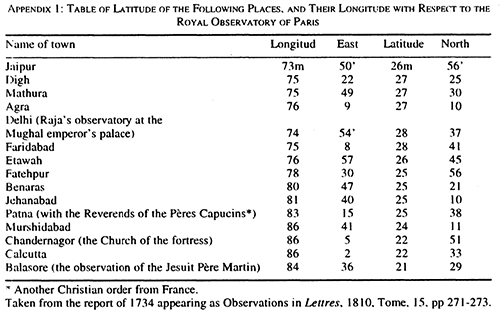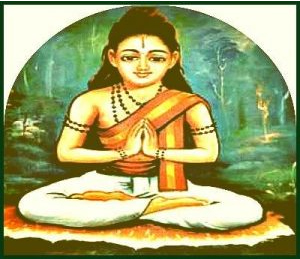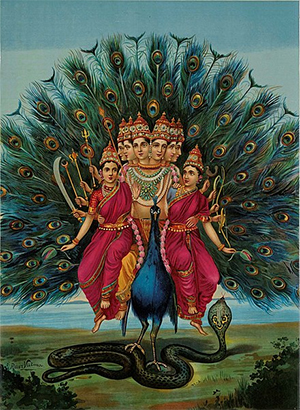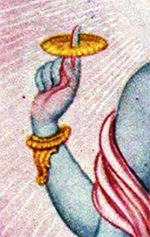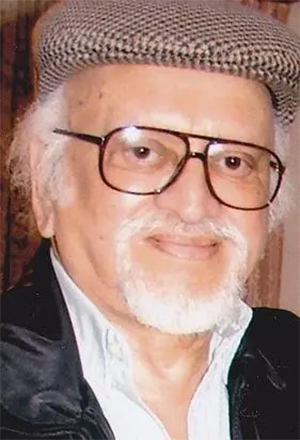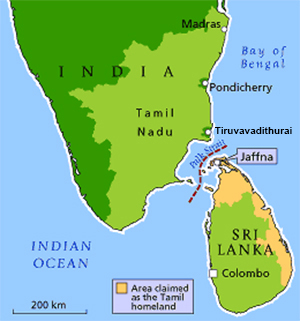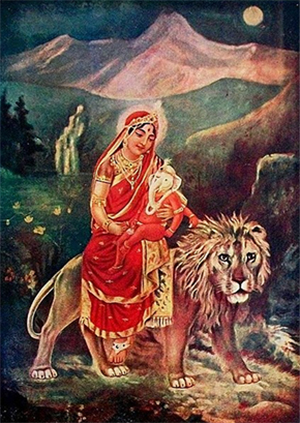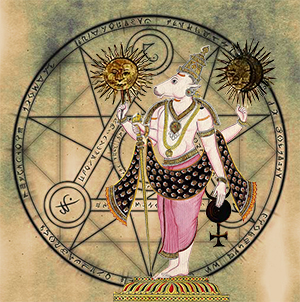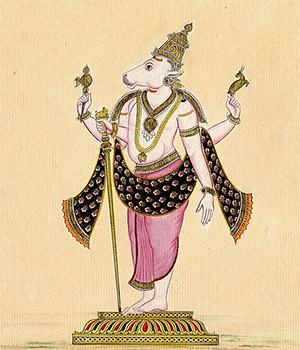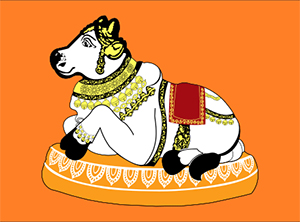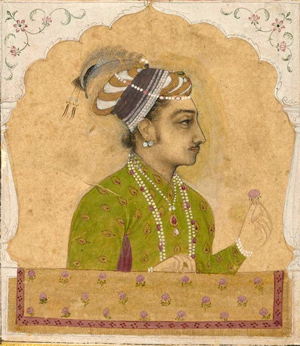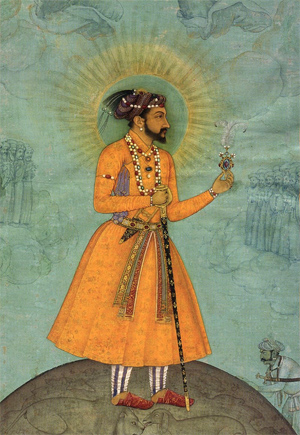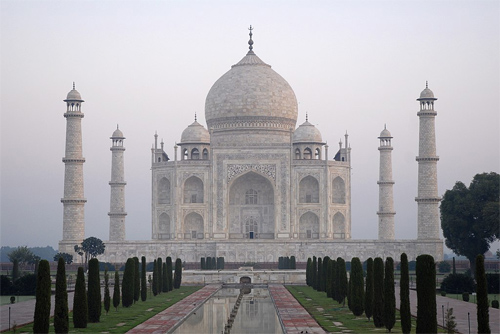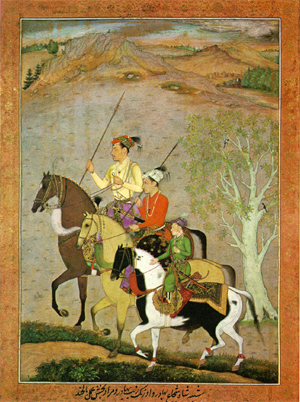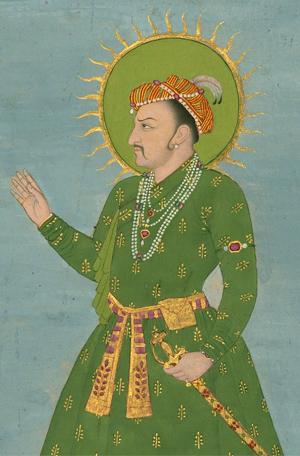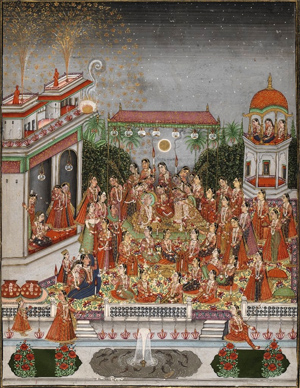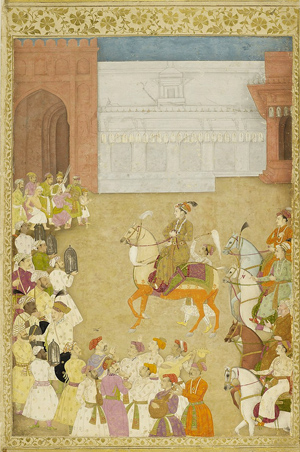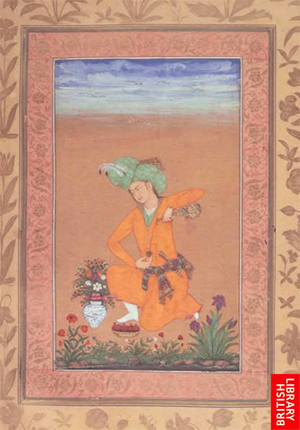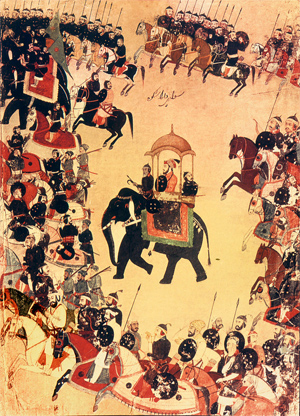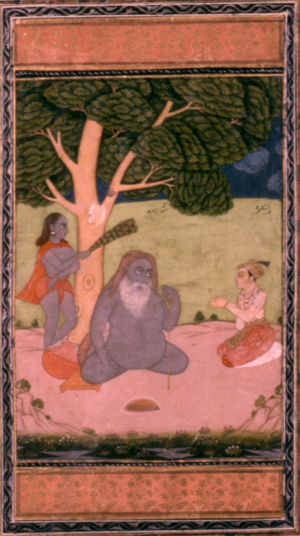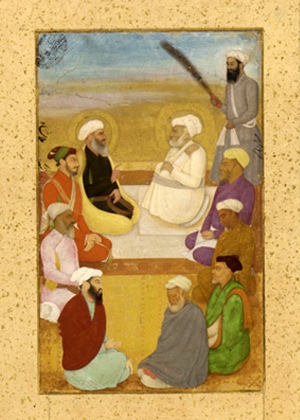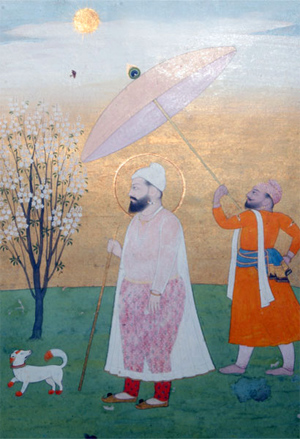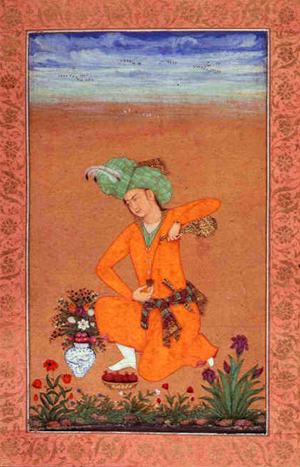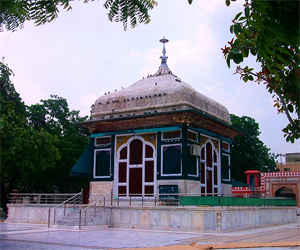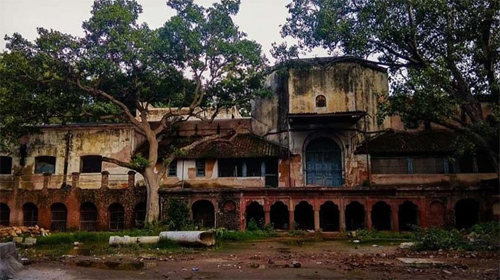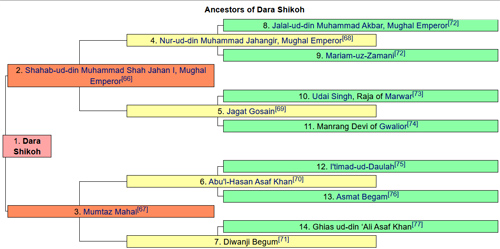THE DUCHAMP MANUSCRIPTS
In order to reassert the point regarding Gaubil as an authoritative figure within the realm of Jesuit science we must briefly discuss two other Jesuit scientists in India, Pere Patouillet and Pere Xavier Duchamp. Two of three important sources for the history of astronomy in India appearing in Jean-Sylvain Bailly's Traite de l'astronomie indienne at Orientale [Bailly 1787 and Delambre's history of astronomy [Delambre 1817 and 1819], were based on Jesuit reports of Sanskrit manuscripts. One of them was sent by Pere Patouillet from India to the astronomer Joseph de Lisle in 1750. This was a copy of the Pancanga Siromani [Panchanga Shiromani].
The Hindu calendar, Panchanga or Panjika is one of various lunisolar calendars that are traditionally used in the Indian subcontinent and Southeast Asia, with further regional variations for social and Hindu religious purposes. They adopt a similar underlying concept for timekeeping based on sidereal year for solar cycle and adjustment of lunar cycles in every three years, but differ in their relative emphasis to moon cycle or the sun cycle and the names of months and when they consider the New Year to start. Of the various regional calendars, the most studied and known Hindu calendars are the Shalivahana Shaka found in the Deccan region of Southern India, Vikram Samvat (Bikrami) found in Nepal, North and Central regions of India – all of which emphasize the lunar cycle. Their new year starts in spring. In regions such as Tamil Nadu and Kerala, the solar cycle is emphasized and this is called the Tamil Calendar (Though Tamil Calendar uses month names like in Hindu Calendar) and Malayalam calendar and these have origins in the second half of the 1st millennium CE. A Hindu calendar is sometimes referred to as Panchangam, which is known also known as Panjika in Eastern India.
The ancient Hindu calendar conceptual design is also found in the Hebrew calendar, the Chinese calendar, and the Babylonian calendar, but different from the Gregorian calendar. Unlike the Gregorian calendar which adds additional days to the month to adjust for the mismatch between twelve lunar cycles (354 lunar days) and nearly 365 solar days, the Hindu calendar maintains the integrity of the lunar month, but inserts an extra full month by complex rules, once every 32–33 months, to ensure that the festivals and crop-related rituals fall in the appropriate season.
The Hindu calendars have been in use in the Indian subcontinent since Vedic times, and remain in use by the Hindus all over the world, particularly to set Hindu festival dates. Early Buddhist communities of India adopted the ancient Vedic calendar, later Vikrami calendar and then local Buddhist calendars. Buddhist festivals continue to be scheduled according to a lunar system. The Buddhist calendar and the traditional lunisolar calendars of Cambodia, Laos, Myanmar, Sri Lanka and Thailand are also based on an older version of the Hindu calendar. Similarly, the ancient Jain traditions have followed the same lunisolar system as the Hindu calendar for festivals, texts and inscriptions. However, the Buddhist and Jain timekeeping systems have attempted to use the Buddha and the Mahavira's lifetimes as their reference points.
The Hindu calendar is also important to the practice of Hindu astrology and zodiac system as well as observing special appearance days of the Lord and fasting days such as Ekadasi....
Siddhānta Śiromaṇi (Sanskrit: सिद्धान्त शिरोमणि for "Crown of treatises") is the major treatise of Indian mathematician Bhāskara II. He wrote the Siddhānta Śiromaṇi in 1150 when he was 36 years old. The work is composed in Sanskrit Language in 1450 verses.
-- Hindu calendar, by Wikipedia
The manuscript may have come from Masoulipatnam or Narsapur, but Bailly felt that it came from Benaras that has the same meridian as Narasimhapur, whose provenance was questionable [Sen 1985: 50]. The manuscript of Duchamp, or the Xavier manuscript as Sen refers to it, could be a copy of a treatise on Hindu astronomy authored by Duchamp, that he had mailed to Gaubil then in Beijing [Sharma 1982:348]. Copies of some of Duchamp's manuscripts are extant at the archives francaises de la Compagnie de Jesus at Vanves, Paris [Duchamp]. Most of these are not Sanskrit manuscripts, but accounts of Indian astronomical practices, calculations of eclipses based on the explication of the procedure followed by Tamil astronomers at Pondicherry, and contain a glossary of astronomical terms employed in Sanskrit and Tamil. Both Patouillet's manuscript and the Duchamp manuscript were the focus of much discussion with the astronomers Bailly, Laplace and Delambre.
Pere Duchamp's manuscript suggests that within the Indian astronomical tradition there existed many methods for calculating the equations of the sun, moon and the planets. At the time, the manuscript was prepared, Pere Duchamp had not deciphered the steps in the operation employed to calculate the time for the commencement and the duration of eclipses. The procedures he documents have to do with those operations that were employed to calculate past eclipses. To validate his reconstruction of the computations of the brahmins, Duchamp requested the help of a brahmin astronomer, and used his method as an exemplar in order to illustrate the procedure employed [Duchamp: folio 000002]. It is during this ethnographic [relating to the scientific description of peoples and cultures with their customs, habits, and mutual differences.] phase of French Indology, that the Surva Siddhanta begins to be canonised as the Indian Almagest [Almagest: an influential treatise on astronomy written by the Greek astronomer and geographer Ptolemy in the second century AD.].
The Surya Siddhanta (IAST: Sūrya Siddhānta; lit. 'Sun Treatise') is a Sanskrit treatise in Indian astronomy from the late 4th-century or early 5th-century CE, in fourteen chapters. The Surya Siddhanta describes rules to calculate the motions of various planets and the moon relative to various constellations, diameters of various planets, and calculates the orbits of various astronomical bodies. The text is known from a 15th-century CE palm-leaf manuscript, and several newer manuscripts. It was composed or revised c. 800 CE from an earlier text also called the Surya Siddhanta.
As described by al-Biruni, the 11th-century Persian scholar and polymath, a text named the Surya Siddhanta was written by one Lāta. The second verse of the first chapter of the Surya Siddhanta attributes the words to an emissary of the solar deity of Hindu mythology, Surya, as recounted to an asura called Maya at the end of Satya Yuga, the first golden age from Hindu texts, around two million years ago.
The text asserts, according to Markanday and Srivatsava, that the earth is of a spherical shape. It treats Sun as stationary globe around which earth and other planets orbit, It calculates the earth's diameter to be 8,000 miles (modern: 7,928 miles), the diameter of the moon as 2,400 miles (actual ~2,160) and the distance between the moon and the earth to be 258,000 miles (now known to vary: 221,500–252,700 miles (356,500–406,700 kilometres). The text is known for some of earliest known discussion of sexagesimal fractions and trigonometric functions.
The Surya Siddhanta is one of the several astronomy-related Hindu texts. It represents a functional system that made reasonably accurate predictions. The text was influential on the solar year computations of the luni-solar Hindu calendar. The text was translated into Arabic and was influential in medieval Islamic geography.
-- Surya Siddhanta, by Wikipedia
It is very likely that Duchamp was unable to decipher the Siddhantic rules for calculating eclipses. The method he encountered was probably the 'vaikiam'. Since Duchamp was unable to discover the textual source of the method he concluded that the method itself was forgotten amongst the practitioners of Indian astronomy and astrology. This textual dissonance is reflected in his explanation that is articulated from his location both in terms of cultural superiority, as well as the Jesuit construction of the brahmins as adversarial authorities. The brahmins would not have shared their knowledge of their method or divulged its source for they would have lost a livelihood had they done so. Secondly, Duchamp felt that they would have lost a sense of correctness of their science. This criticism drew upon the quintessentially renaissance premise regarding the virtues of the democratisation of knowledge.
The letters of the Jesuits [Lettres 1810] are not only important from the point of view of literature, but provide us of the first accounts of a country derived from a textual knowledge of Sanskrit. It was Nobili who had created an interpretive tradition that privileged the written text as being the voice of a civilisalion [Zupanov: 126]. A number of Sanskrit texts were sent to the Bibliotheque royale in Paris; but these were largely texts of scriptural value. In this fascination with textually inscribed knowledge, Duchamp saw the brahmins as the only literate interlocutors in India, who no longer appreciated their rich textual legacy; and hence even they were in a sense illiterate.12 The positioning of such interpretations within the discourse of India gave credence to the idea of the wisdom of an ancient people which had been disfigured. The theory of the lost ancient peoples was to serve, within appropriate contexts, as a device for maintaining their constructions of non-western peoples, that could in turn legitimate imperial control and programmes.
As far as astronomy proper was concerned the Indians had forgotten the theoretical context of their astronomy (read textual) and knew only how to calculate, and even these calculations of meridians, by now a Jesuit specialty, and eclipses were not accurate [Duchamp]. Consequently, Duchamp indicates that the native astronomers had predicted that the eclipse of July 29, 1730 would be partial and the disk would be of the order of 3/4, when it was actually 4/12. Furthermore, given the Jesuit interest in chronology, Duchamp was unable to find the formula to convert the Indian calendars to the western one. Nevertheless, he specifies that the sources from Thailand would provide important material and throw some light on the equation of the centre [Duchamp: folio 000154]. However, in a letter to Souciet dated January 3, 1733, Duchamp retracted some of his remarks concerning the correctness of some of the Indian astronomical procedures, especially those related to the calculation of latitudes [Duchamp 1733].
Pere Calmette collaborated with the Carnatic mission for 15 years and studied the sciences and monuments of India, and discovered the similarity between the Indian and European zodiac, which in turn reminded him of Greece [Bamboat 1933:98]. However, we should note that when it came to the astronomical sciences, the Jesuits based their reconstruction on the recounting of astronomical practices, the era of textual reconstruction was a century away. In this, the contrast with China is substantial. Furthermore, the Jesuit scientists of the late 17th and early 18th centuries were inaugurators of a discourse on India and Indian historical astronomy marked by ambiguity, where fascination and dismissal go together: where the enchantment with the new world and its distinct knowledge forms provide the occasion for enriching the self in cognitive and cultural terms, and through a simultaneous act of distantiation, of redefining the self as superior. The terms of this engagement were defined by the contemporaneous preoccupations of late 17th and early 18th century Europe and France in this case. Despite the overwhelming dimensions of this intellectual landscape that provided Jesuit science with its crucial identity, Indian voices gradually imposed what Zupanov calls "their own horizon of interpretation" [Zupanov 1993:143]. But it is this new self-assurance in the idea and culture of Europe that possibly prompted Bamboat's remarks that the 17th century voyagers couldn't appreciate the beauty and depth of the literature and sciences of India [Bamboat 1933:146].
COGNITIVE AND CULTURAL HORIZON OF THE LETTRES
The Lettres were first published in 1704 and its audience was the church of France, clerics and devotees [Murr 1983: 238]. The collection of letters sought to inform this devout readership of the work of the foreign missions and the difficulties that afflicted them. It also served three other strategies on the political, economic and apologist planes. In political terms, the Lettres constantly provided evidence of missionary activity in the service of the glory of the king of France [Murr: 238]. The economic strategy was designed to attract resources for missionary activity abroad. Thus the Lettres served as publicity material to attract funds for the Society [Murr: 239]. As apology, the Lettres served as an instrument of religious propaganda, to point out to Catholic devotees that god was always amongst them and constantly intervened to assist those who served with religious zeal. But a more significant task was to combat libertines, atheists, skeptics and the attacks mounted by the philosophes. The letter of Pere Bouchet to M Huet, former Bishop of Avranches is an exemplar of this genre of philosophical and religious combat [Lettres 1810. Tome 12: 136-93]. Here, the author very subtly sets up a distance between Catholic doctrine and the views of the Pythagoreans and their Indian counterparts. The scientific agenda of the Jesuits never prevailed upon the strategic intentions. If in the course of their explorations they came across an Indian work that provided a more accurate, authentic account, Murr argues, they would certainly not have communicated it to Europe unless they felt that the cause of their religion would gain something: for the underlying belief was that the civil customs and religious beliefs of the Indians were undesirable for Christians in France. Thus Murr goes on to write that scientific finality was subordinated to pastoral finality [Murr 1983: 240]. Letters mailed from India by the Jesuits that travestied this official image of the country were either unscrupulously torn, edited, censored or modified by the editors of the Lettres [Murr 1983: 240]. Furthermore, as far as the transmission of scientific knowledge was concerned, we see no mention of Copernicus, Kepler or Galileo in their letters. In fact, during their expedition to Jaipur, it is not clear whether Peres Boudier and Pons even appraised Jai Singh of the Copernican system.[!!!]13
There was a change in publication practices of Jesuit astronomers in India and China at the turn of the 17th and early years of the 18th century. The astronomical observations made by the Jesuits were regularly mailed back to Paris by the Jesuit-mathematicians of the king till the end of the 17th century. With the commencement of the 18th century the Jesuits preferred their own works on astronomy, or published their observations from their foreign missions in journals such as Journal de Trevoux [Murr: 243], that was established in 1701 and continued publication till 1767. Amongst a range of doctrinal debates and polemics the journal served as a forum for the publication of the scientific researches of the Jesuits. This possibly explains Heilbron's observation that after 1700 Jesuit scientists authored about 600 articles in scientific journals [Heilbron 1989: 41]. It is only in the second half of the 18th century after the Society of Jesus was suppressed, and the Lettres were terminated, that the Academie des Sciences became interested in anthropological terms in producing a positive discourse on India, devoid of partisan influences [Murr 1983: 243].
The information on India and the images of India appearing in the Lettres, Murr suggests, are enveloped in a rhetoric where the relations of alterity between the French and the brahmins simultaneously develop along three levels. The first is a radical alterity, where India is presented as an elsewhere [Murr. 1986: 15]. Throughout the first half of the 18th century, the Jesuits reaffirmed that paganism was a form of madness and the unhappy Indians were prey to the delirium of a mythology as monstrous as that of the Greeks and Romans. Thus the translation of beliefs, superstitions and ritual practices were constantly aimed at presenting elsewhere as an elsewhere that was radical and close to an inverted image of here. It was an ideological and fantasmatic elsewhere, signifying that the church was the fount of enlightenment, truth and reason [Murr 1986: 15-16]. The second is similitude: India is presented as an other here. At the same time, as the Indians were presented as anti-Christians, they were considered as similar to the Europeans. Like the philosophes, the Jesuits affirmed that human nature was identical and that exotic particularities were inessential. But this founding idea of human nature was not based on some rational anthropology, but was theological since rationality was constantly subject to the dictates of dogma [Murr 1986: 17]. The third sense was as exemplar: India is presented as a Utopia. There were two types of Utopia, the first was Christian and the second 'systeme de police ideal' -- the social order [Murr 1986: 19]. In the case of the Christian Utopia, the original purity of the missionary conferred on them a legitimacy that sui generis they believed endowed authority on the first apostles and apologists in their apostolic work and from whom they adopted a model of autonomy in judgment vis-a-vis the Vatican. In the second type of utopia, the social order of the Indians was presented in certain letters as an ideal model, where all social life was subordinated to the sacred order, the clergy was the fount of temporal power and that all social order was scrupulously observed and social pressure conserved values. This was the dream system of the Jesuits where natural life was mediated by social life, subsumed in turn by the reality of the sacred order [Murr 1986: 21-22].
INTERPRETING BIBLE AND MAPPING EARTH
Amongst the French Jesuits who came to India were a number of Jesuit astronomers. While their task in India was primarily related to conversions, these Jesuit scientists played the important role of surveyors of this new domain. Even within their role as evangelists, they were predisposed to accomodatio as a missionary strategy, that had been perfected by Nobili and embraced by the Jesuits of the Madurai, Carnatic and Mysore missions. Furthermore, Nobili's strategy included adopting local cultural practices, and more importantly consisted in recognising the brahmins as the savants on the Indian subcontinent. The brahmins were thus projected simultaneously as adversaries, whose cultural practices were to be emulated in India by the Jesuits in order to further the cause of the French king and more importantly, the church. On the other hand, the brahmins were also considered the repositories of the cultural and intellectual treasures of India, and it was through them that Europe would be enlightened about this ancient land.
Hence, in the letters these Jesuits wrote home, we find a panel of images of India, most of which persisted throughout the French enlightenment, as well provided the founding tropes of Orientalism. However, these letters were also the source of much scientific information on the geography, botanical resources and medical practices of India -- material for the historian of science. This material has not been meticulously investigated by historians of science, for reasons that partially have to do with self-imposed obstacles within the historiography of sciences. The scientific investigations of the Jesuits have for long been neglected. In addition, to the material appearing in the Lettres the Jesuits published their scientific findings in reports, in particular of astronomical observations, and scientific journals in the early decades of the 18th century.
While the era of textual studies on the history of astronomy of India did not commence till the birth of British Orientalism, the Jesuits provided an ethnographic account of the prevalent astronomical practices, and these accounts later went on to shape the subsequent reconstruction of Le Gentil, Jean-Sylvain Bailly and Laplace. Within the overarching frame of the 'discours sur l'Inde', the Jesuits simultaneously contributed to promoting an interest in the subject amongst practising astronomers from the age of the enlightenment. Beyond the fascination with this ancient knowledge, the Jesuit accounts were punctuated with markings of caution, that this ancient knowledge could not possibly have been generated amongst these fallen people, who had possibly disfigured a wisdom that had arrived from elsewhere. By the 1830s or thereabouts the idea that other civilisations could have had a 'science' as conceived by the Enlightenment came to be regarded with increasing scepticism. While India and Iran were possibly exceptions, the Orientalists had framed them as part of the Indo-European family. As Bernal succinctly puts it they filled the "niche of exotic ancestors" [Bernal 1987:236].
APPENDIX 1: TABLE OF LATITUDE OF THE FOLLOWING PLACES, AND THEIR LONGITUDE WITH RESPECT TO THE ROYAL OBSERVATORY OF PARIS
Name of town / Longitud / East / Latitude / North
Jaipur / 73m / 50' / 26m / 56'
Dligh / 75 / 22 / 27 / 25
Mathura / 75 / 49 / 27 / 30
Agra / 76 / 9 / 27 / 10
Delhi (Raja's observatory at the Mughal emperor's palace) / 74 / 54' / 28 / 37
Faridabad / 75 / 8 / 28 / 41
Etawah / 76 / 57 / 26 / 45
Fatehpur / 78 / 30 / 25 / 56
Benaras / 80 / 47 / 25 / 21
Jehanabad / 81 / 40 / 25 / 10
Patna (with the Reverends of the Peres Capucins*) / 83 / 15 / 25 / 38
Murshidabad / 86 / 41 / 24 / 11
Chandernagor (the Church of the fortress) / 86 / 5 / 22 / 51
Calcutta / 86 / 2 / 22 / 33
Balasore (the observation of the Jesuit Pere Martin) / 84 / 36 / 21 / 29
* Another Christian order from France. Taken from the report of 1734 appearing as Observations in Lettres, 1810, Tome, 15, pp 271-273.
Jesuit interest in Indian astronomy had to do in turn with two raging Biblical themes: that of the commencement of the world and that of dating the deluge. Astronomy and the scientific interpretation of passages of the Bible would provide the hermeneutic to decode the precise history of these events. The skies, as in eras past offered the key to scriptural enlightenment. Jesuit interest in the astronomy and chronology of the Chinese and Indians was prompted by the need to explicate these events, in case other traditions had an answer to these quandaries or provided evidence that would validate the claims of the European astronomers. The antiquity of Indian civilisation provided the pretext for clarifying burning questions on chronology. The debate was organised around history, and the coherence of the Judeo-Christian world founded on the sacred chronology of the scriptures [Murr 1983: 249]. Indian chronology, as evidenced in the astronomical sources, would provide the final validation that the Indians could not have predated the deluge that was supposed to have transpired 3,500 years ago. Pere Bouchet and Pere Calmette, cited earlier, in 1767 sent a chapter to the Academie des Inscriptions et Belles Lettres on 'Sciences de Brahmies, epoque du Deluge' [Google translate: Sciences of Brahmies, era of the Deluge.] [Murr 1983: 253]. This preoccupation persisted in to the age of the enlightenment. Dating the deluge served three ends. Firstly, it provided a secular, scientifically validated account of certain primal episodes recounted in the Bible. Secondly, it possibly certified that Judeo-Christian civilisation predated its Indian counterpart. Finally, there was both the scientific and religious issue to be settled, as to when the universe was created -- a key anxiety for scientists and Christians since the time of Newton. Newton during the later years of his life was ensconced in the world of alchemy, astrology and magic. But these were rather discredited predilections within a century of his death. This possibly had to do with the triumph of capitalism in England and Holland and statism In France [Bernal 1987:169]. We are however still located within the Jesuit world where these scriptural concerns were significant to the scientific practices of the Jesuits -- and this should not surprise us. For in this 'deeply religious age', the book of nature was as much a source of the natural philosopher's knowledge as divine knowledge was of Scripture [Shapin 1996: 137]. While an independent existence was sought for natural philosophy, science could extend support to religious beliefs [Shapin 1996: 137].
The other dimension of the interest in the antiquity of Indian civilisation was to establish a certain direction of cultural diffusion. This direction would be essential to founding Europocentrism, and the idea that Greece was the epitome of European scientific culture. The historical device, that we encounter within the archive of Jesuit science, and that is frequently reiterated in the Enlightenment writing of historians of astronomy, is to draw upon various cultural analogies between the Occident and the Orient, and explain these analogies in terms of a cultural transmission from the west to the east [Murr 1983: 253].
This trend ran parallel with the suggestion of the Academie in 1744 to compose the history of India for itself. Outside the Jesuit circle, then the Academy sought to install Orientalism as contrary to Europocentrism. This complement to universal history, combined the hermeneutic method with comparative etymology to prove that Bacchus was none other than Osiris, who was none other than Esau, who was none other than Iswara in the Indian tradition. But this too was a superfluous alteration of the cosmogony of Moses [Murr 1983: 250]. It is not our purpose here to discuss the 18th century French Orientalists, but to highlight the key themes elaborated by the French Jesuits that shaped the subsequent historical discourse on the astronomy of India, occasioned by French astronomers of the Enlightenment decades. By the time the Jesuit order was suppressed in the third quarter of the 18th century, astronomy had moved into the hands of secular astronomers who embarked on expeditions overseas, to either India, China, South America. The perseverance of the Jesuits though never acknowledged, would echo in the Laplacian synthesis of celestial mechanics. And even though the images of India communicated by Jesuits would endure in the history of science, the labours of the British Orientalists would alter the terms of the discipline, such that Orientalism itself would become a discourse constitutive of the history of science in the 19th century.
APPENDIX 2: GLOSSARY OF ASTRONOMICAL TERMS IN THE TEXT
Celestial meridian: a great circle on the celestial sphere, passing through the two celestial poles on the observer's zenith.
Ecliptic: the apparent annual path of the sun among the stars; the intersection of the plane of the earth's orbit with the celestial sphere.
Emersion: the appearance of a celestial body after and eclipse or occultation.
Immersion: the disappearance of a celestial body either by passing behind another or passing into another's shadow.
Meridian altitude: the altitude of a celestial body when it is on the celestial meridian of the observer, hearing 000° or 180°.
Meridian passage: the passage of a celestial body across the observer's meridian.
Meridional: pertaining to longitudinal movements or directions that is northerly or southerly.
Meridional difference: the difference between the meridional parts of any two given parallel latitudes: this difference is found by subtraction if the two parallels are on the same side of the equator, and by addition if on opposite sides.
Metonic cycle: a time period of 235 lunar months, or 19 years 11 days; after this period the phases of the moon occur on the same days of the month.
Obliquity of the ecliptic: the acute angle between the plane of the ecliptic ande the place of the celestial equator, about 23"27'.
Sidereal month: the time period of one revolution of the moon about the earth relative to the stars; this period varies because of perturbations. but is less than 27 1/3 days.
Sidereal year: the time period relative to the stars of one revolution of the earth around the sun; it is about 365.2564 mean days.
Synodic month: a month based on the moon's phases.
_______________
Notes
[This paper is the preliminary portion of a larger study on India in the landscape of Enlightenment historiography of sciences. I take this opportunity to thank Jean-Marie Lafont of the Centre de Sciences Humaines, for introducing me to the Jesuit archive at Vanves, and helping me out with 18th century French, where the French-English dictionaries failed me; Catherine Jami of REHSEIS (CNRS). Paris, for her help with the Duchamp manuscript, and her own insights on the science of the Jesuits; S Irfan Habib of NISTADS, New Delhi, for his ready discussion, Jacques Pouchepadass from EHEIAS. Paris, for acquainting me with the Lettres Edifiantes and the work of Sylvia Murr.]
1 An important work from the end of the 17th century published by the L'Imprimerie Royale in 1692 is the Observations Physiques et Mathemnatiques pour servir a l'Histoire Naturelle Envoyees des Indes et de la Chine a l'Academiie des Sciences a Paris.
2 Joseph Needham has chronicled the contributions of the Jesuits in China to the emergence of French science [Needham 1959].
3 Historical astronomy is a term employed by Han, that we shall attempt to elaborate later in the essay.
4 One of the first astronomical texts produced in French based on a collection of Sanskrit astronomical manuscripts is that of Abbe Guerin that appeared in 1847, and he mentions that he was aided in his efforts by members of the Asiatic Society, Calcutta.
5 For example, the arrival of the French "King's Mathematicians" in China precipitated an acute conflict between the French Jesuits and the already resident Portuguese Jesuits. Jami writes: "what in Europe was an attempt to break Portugal's monopoly of the sponsorship of Asian missions on the one hand, and a conflict of power between Paris and the Vatican for the control of church institutions on the other, was reflected in China by a split between French and Portuguese...Jesuits" [Jami 1995:496].
6 For a study of the image of India in the accounts of the Portuguese Jesuits see [Bouchon 1988].
7 A 19th century account of the French missions in India is to be found in the well known [Launay 1898], and draws upon the archives of a number of missions.
8 A 19th century account of the French missions in India is to be found in the well known [Launay 1898], and draws upon the archives of a number of missions.
9 See the letter written by Pere Papin to Pere le Gobien, also of the Society of Jesus, from 'Bengale' on the December 1, 1709 [Lettres, Tome I 1: 202-209]. The letter is a description of the textile and mechanical arts of Bengal as well as contains a description of medical practices. This is followed by a second letter, dated 1711 and sent from Chandernagore, detailing the medical practices encountered in Bengal [Lettres, Tome 11: 209-215]. The interesting feature about the letter is the comparative perspective adopted in narrating these practices.
10 The paper by Forbes chronicles the era of the Portuguese Jesuit astronomers in India during the 16th and 17th centuries.
11 Much later D'Anville recalculated the longitude of Delhi with respect to the meridian of Ferro as 94° 54', while Boudier's value was 74° 54' with respect to Paris. Similarly for Chandernagore D'Anville gives Boudier's value with respect to Paris as 86° 5' [Sen 1982: 7].
12 Much later, with the rise of British Orientalism, Sanskrit was considered in an analogous relationship to the Indian vernaculars as Greek and Latin were to the European ones. Thus they focused their explorations on ancient Sanskrit literary, philosophical and scientific works, and their privileged interlocutors were their 'subcontinental counterparts', the brahmins who mastered Sanskrit [Raj 1996: 288].
13 Sharma mentions a letter from the Portuguese Jesuit Figuerado that discusses Copernicus. This letter appears in the 1781 edition of the Lettres, but is not found in the 1810 edition [Sharma 1982: 352]. This is interesting for one of the leading Jesuit scientists of the 18th century Ruggiero Giuseppe Boscovich (1711-1787) played a significant role in revising the ecclesiastical hostility to Copernicus' astronomy.
References
Ansari, S M Razaullah (1985): 'Introduction of Modern Western Astronomy in India during 18-19 Centuries in S N Sen and K S Shukla (eds), History of Indian Astronomy, INSA. New Delhi, pp 363-402.
Bailly, Jean-Sylvain( 1787): Traitedel 'astronomie indienne et Orientale, Paris: Libraire de la Bibliotheque du roi et de l'acadenie des inscriptions et Belles Lettres.
Bamboat, Zenohia (1933): Les Voyageurs Francais aux Indes aux XV11c et XVIIe Siecles. Jouve & C. Editeurs. Paris.
Bernal, Martin 1987): Black Athena: The Afroasiatic Roots of Classical Civilisation. Free Association Books, London.
Bouchon, Genvieve (1988): 'L'Image de l'lnde dans l'Euope de la Renaissance'. Purusartha. 11. pp 69-90.
Delambre, Jean-Baptiste Joseph (1817): Histoire d'astronomie ancienne. Tome 1. Imprimeur Libraire pour les Sciences, Paris.
- (1819): Histoire de l'astronomie du moyenage, Courcier. Pars.
Dieny, Colette (1995) 'Knowledge and Appreciation of Chinese Astronomy and History in Eighteenth Century Europe According to the Writings of Antoine Gaubil S J (1689-1759)' in Hashimoto Keizo. Catherine Jami and Lowell Skar (eds). East Asian Science: Tradlition and Beyond, Kansai University Press, Osaka, pp 501-05.
Duarte, Adrian (1932): Les premiere relations entre les Francaise et les princes indigenes dans l'Inde au XVII siecle (1666-1706), Jouve & C. Editeurs. Paris.
Duchamp. Xavier (1733): Lettre du P Duchamp au P Souciet, recue en 1733. Archives francaises de la compagnie de Jesus, Vanves. Volume 83. 83GBro 083 p 7; ff166-69.
Duchamp, Xavier (about 1734): Sur le Calcul des planetes selon la methode Graha Chhendrika: pour calculer les eclipses. calculs divers. Archives franchises de la compagnie de Jesus. Vanves. Volume 83. 83GBro 083 71 p. ff 119 -55
Eco, Umberto (1994): The Island of the Day Before. Minerva.
Forbes, Eric (1982): The European Astronomical Tradition: Its Transmission into India, and its Reception by Sawai Jai Singh II', Indian Journal of History of Science, 17, 2, pp 234-43.
Guenn, M L. J M F Abbe (1847): Astronomie Indienne. D'Apres la doctrrine et les livres anciens et modernes des Brames sur l'astronomir. l'astrologie et chronologie L'Imprimerie Royale. Paris.
Han, Qi (1995): 'The Role of French Jesuits in China and the Academie Royale des Sciences in the Development of the Seventeenth- and Eighteenth-Century European Science' in Hashimoto Keizo. Catherine Jami, and Lowell Skar (eds). East Asian Science: Tradition and Beyond, Kansai University Press, pp 489-92.
Harris, Steven J (1989): 'Transposing the Merton Thesis: Apostolic Spirituality and the Establishment of the Jesuit Scientific Tradition'. Science in Context. 3, 1, pp 29-65.
Heilbron, J L (1989): 'Science in the Church'. Science in Context. 3, 1. pp 9-28.
Jami, Catherine (1993): 'French Science Overseas'. Kansai Daigaku Shakaigaku bu Kiyo (Bulletin of the Faculty of Sociology: Kansai University), 25. 2, 1993, p 133-48.
- (1995): 'From Louis XIV's court to Kangxi's Court: An Institutional Analysis of the French Jesuit Mission to China (1688-1722), in Hashimoto Keizo. Catherine Jami, and Lowell Skar (Eds). East Asian Science: Tradition and Beyond, Kansai University Press. Osaka. pp 493-99.
Launay, Adrien ( 1898): Histoire des Missions de l'Inde: Pondichery, Maissour, Coimbatour: Tome Premier, Ancienne Maison Charles Doumol, Paris.
Lettres Edifiantes el Curieuses: Memoires de l'Inde (1810): Tomes 11-15. Noel-etienne SENS. ___meur Libraire, Toulouse.
Murr. Sylvia ___): 'Les conditions d'emergence du discours sur l'Inde au Siecle des Lumieres. Collection Purusartha. 7. pp 233-84.
- (1986): 'Les Jesuites et l'lnde au XVIII' siecle: Praxis. utopie. preanthropologie', Revue de l'Universite d'Ottawa, 56. 1, 1986, pp 9-27.
Needham, Joeseph (1959): Science and Civilization in China, vol 3, Cambridge University Press, Cambridge.
-Observations Physiques et Mathematiques pour servir a l'Histoire Naturelle Envoyees des Indes et de la Chine a l' Academie des Sciences a Parisparles Peres Jesuites avec les Reflexions de M de Academie et les Notes des P Gouye, de la Comnpagnie de Jesus. L'Imprimerie Royale, Paris, 1692. (Copy at the Archives de l'Academic des Sciences. Paris.
Pyenson, Lewis (1993): Civilisiing Mission: Exact Sciences cnd French Expansion, 1830-1940, The John Hopkins University Press: Baltimore and London.
Raj, Kapil (1996): 'Christian Confessions and Styles of Science in Nineteenth Century Bengal' in Patrick Petitjean (ed). Les Sciences Coloniales: Figures et Institutions, ORSTOM Editions, Paris, pp 285-97.
Sen. S N (1982): 'Tiffenthaler on Latitudes and Longitudes of India: An Eighteenth Century Study of Geographical Coordinates'. Indian Journal of History of Science. 17.1. pp 1-17.
- (1985): 'Survey of Studies in European Languages' in S N Sen and K S Shukla (eds). History of Astronomy in India. INSA. New Delhi. pp 49-121.
- (1988): 'The Character of the Introduction of Western Science in India during the Eighteenth and Nineteenth Centuries'. Indian Journal of History of Science, 1 and 2, pp 112-22.
Joseph Tieffentaller: Jesuit missionary and noted geographer in Hindustan, b. August 27, 1710; d. July 5, 1785
by A. Huonder
The Catholic Encyclopedia: An International Work of Reference on the Constitution, Doctrine, Discipline, and History of the Catholic Church
Edited by Charles G. Herbermann, Ph.D., LL.D., Edward A. Pace, Ph.D., D.D., Conde B. Pallen, Ph.D., LL.D., Thomas J. Shahan, D.D., John J. Wynne, S.J., Assisted by Numerous Collaborators
Fifteen Volumes and Index
Volume XIV
1912
Tieffentallar, Joseph, Jesuit missionary and noted geographer in Hindustan, b. at Bosen in the Tyrol, 27 August, 1710; d. at Lucknow 5 July, 1785, He entered the Society of Jesus 9 October, 1729, and went in 1740 to the East Indian mission where he occupied various positions, chiefly in the empire of the Great Mogul. After the suppression of the Society he remained in India, and on his death was buried in the mission cemetery at Agra, where his tombstone still stands. He was a fine scholar with an unusual talent for languages; besides his native tongue he understood Latin, Italian, Spanish, French, Hindustani, Arabic, Persian, and Sanscrit. He was the first European who wrote an exact description of Hindustan. A brief list of his works is the best proof of his extraordinary power of work and his varied scholarship.
In geography, he wrote a "Descriptio Indiae", that is a circumstantial description of the twenty-two provinces of India, of its cities, fortresses, and the most important smaller towns, together with an exact statement of geographical positions, calculated by means of a simple quadrant. The work also contains a large number of maps, plans, and sketches drawn by himself, and the list of geographical positions fills twenty-one quarto pages. He also prepared a large book of maps on the basin of the Ganges, entitled: "Cursus Gangae fluvi Indiae maximi, inde Priaga seu Elahbado Calcuttam usque ope acus magneticae exploratus atque litteris mandatus a J.T.S. J. " [Google translate: The course of the Ganges, the greatest river of India, thence to Priaga or Elahbado, Calcutta investigated with the help of magnetic needles and a letter received by J.T.S.J."] (1765).
The original map of the lower course of the river measures 15', that of the middle course, from Benares to Patna, measures 4' 3" square. In addition there is a map of similar dimensions of the Gagra, the whole accompanied by numerous notes, sketches of particular parts, and maps giving details— an "enormous labour", as Bernoulli calls it. He also wrote a work on the regions containing the sources of the chief rivers of India. In the field of religions he wrote on Brahminism a work directed against the errors of the Englishmen Z. Holwell and Alexander Dow. Others of his writings were on Indian idolatry, Indian asceticism, the religion of the Parsees, Mohammedanism, the relations of these religions to one another, etc. His writings in the department of the natural sciences are: astronomical observations on the sun-spots and the zodiacal light, studies on the astronomy, astrology, and cosmology of the Hindus, descriptions and observations of the flora and fauna of India. The department of history is represented by writings in Latin on the origin of the Hindus and of their religion, an account in German of the expeditions of Nadir Shah to India, the deeds of the Great Mogul Shah Alam in Persian, and in French the incursions of the Afghans and the conquest of Delhi, and the contemporary history of India for the years 1757-64. In linguistics he wrote a Sanscrit- Parsee lexicon, treatises in Latin on the proper pronunciation of Latin, etc.
Tieffentaller sent these works in manuscript partly to the Danish scholar Dr. Kratzensttiin at Copenhagen, partly to the celebrated French Orientalist and geographer A. H. Anquetil-Duperron (1731-1805). The latter gave due credit to the value and importance of the works, especially those on geography, in his addresses before the French Academy of Sciences ("Journal des Scavans", Dec., 1776), and made the writings of Tieffentaller partly accessible to the learned world in his "Recherches hist, et geogr. sur l'Inde" (1786), and also in his "Carte generale du cours du Gange et du Gagra dressee par les cartes particulieres du P. Tieffenthaler" (Paris, 1784). A part of the manuscripts at Copenhagen were obtained by the German scholar Johann Bernoulli of Berlin who used them in connexion with the "Recherches" of Anquetil for the great work "Des Pater Joseph Tieffenthalers d. Ges. Jesu und apost. Missionarius in Indien historisch-geographische Beschreibung von Hindustan . . ." (3 volumes, quarto, Berlin-Gotha, 1785-87). The greater part of the first two volumes is devoted to Tieffentaller's writings, his maps, and sketches. The French edition, entitled: "Description hist. et geogr. de l'Inde ..." appeared at Berlin in three vols., 4to (1786-91). A large part of his manuscripts are probably still extant in Paris and Copenhagen.
Huonder, Deutsche Jesuitenmissionare des 17. und 18. Jahr. (Freiburg, 18999), 179; Noti, Jos. Tieffentaller, S.J., A Forgetten Geographer of India (Bombaby, 1906); Hosten, Jesuit Missionaries in Northern India (Calcutta, 1907).
Shapin, Steven (1996): The Scientific Revolution, University of Chicago Press, Chicago and London.
Sharma, Virendra Nath (1982): 'The Impact of Eighteenth Century Jesuit Astronomers on the Astronomy of India and China', Indian Journal of History of Science. 17. 2. pp 345-52.
Wallace, William A (1984): Galileo and his Sources: The Heritage of the Collegio Romano in Galileo's Science. Princeton University Press, Princeton.
Zupanov, Ines G (1993): 'Aristocratic Analogies and Demotic Descriptions in the Seventeenth Century Madurai Mission'. Representations, 41, pp 123-47.

